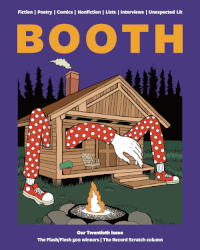Nonfiction by Kylan Rice
At first in flickering gaps, then in a break in the trees along the freeway, I catch a glimpse of another cluster of concrete columns, complex belts, complex of pipelines. It shutters back into the dense woods. Then the view flares open again, and we’re over a big body of water on what used to be a steel through-truss double-deck, now a super-stretch of fresh concrete fixed in the sky on pylons.
I peel my eyes for mile markers, exit signs, so that later I can route back here on a search engine, flesh out this glimpse of a grain elevator.
It turns out not to be for grain at all. The silo cells belong to the Redding extension of the Lehigh Southwest Cement Company, based in Texas. Outside its parking lot, there’s a free-standing bas-relief frieze with two figures—one bare-headed, clutching a gear to his chest, the other casqued in a centurion’s helmet, holding a lamp aloft. The frieze bears an inscription: “Safety Follows Wisdom.”
Back in Colorado, my friend’s Honda Civic takes the turn too quickly into his girlfriend’s cul-de-sac, spins out on ice, and we get to watch the world tilt—blithe ferris-wheelers—as the car grinds to a halt on its own weight.
His is a PhD in O Chem, but he wishes more that he had a jeep, a real man-jeep, stripped of all its extras, so he could go around winching people out of the snow drifts, then send them on their way. Do the world some real—a more concrete—good.
Closer to the city center, snowplows are more thorough sowing gravel. It, too, is mined from someplace, processed, strewn from open hoppers for safety and tread.
You don’t know it, because they are filled up with water and made into lakes, but the fenced-off swatches of blue calm out by Butterfly Woods were good grounds for such gravel. Seven degrees out, I walk the five miles to Martin Marietta Materials, which digs these aggregates out of pits. Under cover of ice and snow, the fake lakes have become vast and unexplored clearings. Big voids barred by chain link.
What filled them now bedrocks the asphalt draped over it like a hot broadcloth. Humming—every now and then a knock below the chassis, indicating a seam or a suture—as people get where they’re going, even just going being plenty.
*
To secure structural integrity for his grain elevator—unadorned, corrugated, slip-formed from concrete—a builder should figure out and account for the coefficient of grain weight, as well as the coefficient of friction during loading and offloading. Rasp of raw dry goods dragged against cylinder walls. The hollow pillar’s ensuing quivering. You risk trauma during voiding, trauma being filled. Cracks on the one hand, explosion on the other.
Look on my works, says the inscription on his pedestal, Ozymandias half in and half out of the lone, level, and semi-fluid sand. The irony of his shattered face somewhere nearby.
Conscious now of the nostril, the hollow where the eye is. The pleasure of a metal pin toy is less the 3D relief you can make of your face and more the cool manyness of all the little rods against your cheek, your forehead, shifting to account for your features as you press it there.
Plunging yourself in total darkness, hoping to render yourself your own image, the result the approximation that impression is. Mouth open, pins irony against the tongue, grotesque comic death mask formed from out of an amenable shallowness.
Even in the semi-fluid, which affords no reflection, I look for my own face. I look for my own face.
In the grain elevator, I look for a symbol. A barrier reef of concrete cylinders. No telling what’s holed up inside. What good. Rice, soybeans, sunflower seeds. Or perhaps it stores up concrete itself. Concrete kept in concrete, stuff of walls, eminent as it is at keeping out the wet.
I keep running aground these, these sound vacuums.
*
As they spread west Americans switched to the silo form, as opposed to the square European warehouses better suited for stacked burlap, because they were dealing more in bulk transport, in the beds of hopper cars and trucks. Early infrastructure of shipping and receiving in the big void inlands. Goods in diastole, in systole.
I am able to feel my own heartbeat deflected back to me, in this pressure I exert on my face.
In cells attached to a headhouse, the silo body gets slip-form poured, new installments of concrete added once every six hours, welling the gap between two yoked wood rings. As soon as the mixture sets, the rings can be raised on screw jacks, making room for a new pour. A block of continuous, unribbed pillars can be erected this way in a handful of days.
Continuous concrete and rebar, barring access to what’s behind it.
*
The question was: How do you make a monolith?
How do you make without segments, seams, sectors of weakness? How do you absorb a vector of pressure? The mute weight of a good? How do you engineer “the walnut-trunk, the walnut-husks, and the ripening or ripen’d long-round walnuts; the continence of vegetables, birds, animals . . .”?
In addition to these blocks of solid hollows, the grain elevator has for a crown an apparatus of routing pipes and wire rigging. The effect is naval, warships with sails furled. Just outside Ault, Colorado, destroyers weigh anchor beside the railroads, a prairie version of the Hudson River Defense Reserve. In 1953, the Reserve was repurposed as a flotilla of water-borne silos: someplace for the US government to store the fifty-three million bushels of surplus subsidized wheat it was obliged to buy from its own farmers, and now had to let rot in the holds and hulls of a peacetime fleet.
The question was: How do you shore up the family farm?
I keep trying to wash up on that shore, that land. I keep hurling myself overboard, hurtling down Highway 287. But even out here, landlocked, I find myself landless. The rocks themselves are adrift, wandering Planctae, Symplegades. A froth of men in their lee. A shattered shipping route.
Not far from the grain elevators of the Eastern Plains, the university hosts an unprepossessing seed bank in a blank building beside a railway that cuts the college town in two. Half a million seed packets in a cold-storage vault laid out on shelves—much like a library. Eleven strains of wild rice preserved for progeny in cryogenic vats. A polysemy. Meaning many seeds, meaning many meanings. They run through the hand, colder than clear water.
It could be soybean. It could be corn. It could be wheat. Hard red, soft white. It could be rice. It could be sugar beet. It could be birdseed, or sun-cured alfalfa. It could be aggregates, gravel. It could be concrete. It could be sub-atoms, on the precipice of fusion or fission, stored in silos repurposed for missiles.
Reality, Joshua tells me as we take a regional bus down to Boulder, is what imposes itself on us. He cites Charles Sanders Peirce. He points to a metal handrail. In that way, a person is no less real than this. Yes, a person can be less real to me than this, depending on how they weigh on me. As he speaks, through the winter and street-salt smear on the window glass, a landscape floats by, barns and silos above his head, goats in a dream-like Chagall.



